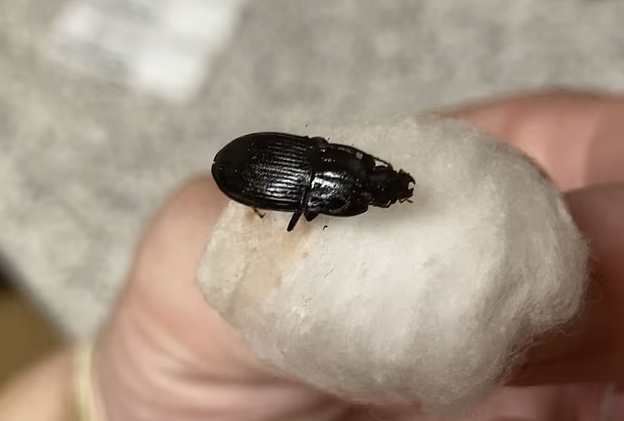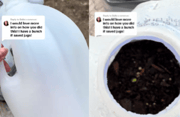
A sharp scratching sound woke Brendan Doyle from a peaceful nap on his new couch.
He froze, convinced something was crawling inside his skull.
Panic surged as he screamed, sending his wife rushing to his side.
The emergency room staff initially assumed drug-induced psychosis. Brendan, 31, a factory worker from Indiana, insisted he hadn’t taken anything, but his frantic behaviour seemed to confirm their suspicion.
'They thought I was going crazy and they asked me if I'd taken any drugs so it felt like they thought I was having a psychotic episode.'
A closer examination revealed the horrifying truth: a two-inch black beetle had burrowed into his inner ear.
'Every sound that it makes is amplified because of how close it is to your ear, and it had pinchers so it was pinching the inside of my ear over and over,' Doyle said.
The beetle’s movements caused sharp, unbearable pain, and every second felt magnified. Medical staff worked carefully, using ointment and cotton balls over an hour-long procedure to kill and extract the insect safely.
Similar cases have been documented in Australia, including one where a man had a cockroach removed from his ear.
ENT specialists report treating patients with insects in their ears at least once a month, and some emergency departments see multiple cases in a single day.
Australians’ sleeping habits generally make these incidents less frequent, offering some reassurance.
Insects enter the human ear easily, but the S-shaped canal makes escape extremely difficult. They often crawl in during sleep or fly in during outdoor activities, drawn by warmth, moisture, and the fatty acids in earwax. Cockroaches appear particularly attracted to these conditions.
Signs of a bug in your ear
- Crawling or scratching sensations
- Sharp or throbbing pain
- Buzzing or movement sounds
- Temporary hearing loss
- Foul smell or discharge
- Minor bleeding
Health Direct Australia advises pouring a small amount of olive oil into the ear to help the insect float out.
Tilting your head sideways and gently shaking may also work. Stanford Medicine warns against using cotton swabs or tweezers, which can push the insect deeper and cause lasting damage.
Medical removal usually requires only local anaesthetic, with just 13.6 per cent of cases needing general anaesthesia.
Doctors may use medical forceps or flush the ear with warm water to extract the insect safely. Afterward, the ear is examined for inflammation or infection, and antibiotics or ointments may be prescribed.
Preventive measures include keeping windows closed while sleeping, using insect repellent in areas with high bug populations, and maintaining a clean, dry environment at home.
Untreated insects can damage the eardrum, cause bleeding, hearing loss, and dizziness, so even dead insects should be removed promptly.
Following the ordeal, Doyle was offered the beetle as a keepsake but politely declined. He now sprays insect repellent regularly and maintains strict pest control in his home.
The story horrified social media, with comments ranging from 'I would have passed out from being so scared!' to 'Great, now I'm putting ear plugs in permanently.'
And there are many other cases. For instance, this video shows a real-life case of a dead beetle being carefully removed from someone’s ear, echoing Brendan Doyle’s terrifying experience.
Watch now to see the unbelievable procedure and find out how easily insects can invade your ears!
What This Means For You
Brendan Doyle endured extreme pain and distress after a beetle made its way into his ear, highlighting just how unsettling such an experience can be.
While similar incidents do occur in Australia, they are less common due to local sleeping habits, offering some reassurance to residents.
Medical experts strongly recommend safe removal techniques and caution against trying to extract insects yourself, as this can worsen the situation.
Prevention and prompt treatment are crucial to avoid long-term ear damage, reminding us all to remain vigilant about keeping our homes and personal spaces insect-free.
These lessons are particularly relevant for anyone who values their hearing and wants to prevent a small nuisance from turning into a medical emergency.
Brendan Doyle’s terrifying encounter with a beetle in his ear isn’t the only time someone has discovered something shocking lodged inside their ear canal.
Sometimes these experiences go unnoticed for years, causing discomfort and potential health risks before the truth is finally revealed.
If you found this story unsettling, you might want to read about another real-life case that left medical staff equally stunned.
Read more: You won't believe what was in this man’s ear for years...
Doctors thought it was drugs — Horrified by the bug inside his ears — Daily Mail article detailing Brendan Doyle’s case of a beetle in his ear and the medical response.
https://www.dailymail.co.uk/health/...-thought-drugs-horrified-bug-inside-ears.html
Insect in ear – about bugs, worms, earwigs & Co. | Amplifon — Discusses various cases of insects in ears worldwide and includes Brendan Doyle’s quote about medical staff thinking he was having a psychotic episode.
https://www.amplifon.com/au/ear-diseases-symptoms/other-problems/insect-in-ear
How Often Do Bugs Crawl Into Sleeping People’s Ears? — Explains the frequency of insects entering ears and the need for professional removal at least monthly.
https://www.terminix.com/blog/bug-facts/how-often-do-bugs-crawl-into-peoples-ears/
How to deal with a bug in your ear? — Provides symptoms, safe removal techniques, and cautions against DIY extraction; confirms that insects in ears are not entirely uncommon.
https://www.connecthearing.com.au/blog/hearing-protection/how-to-tell-if-there-is-a-bug-in-your-ear/
Objects in the ear—treatments, complications and prevention | healthdirect — Offers medical advice on safe removal, use of olive oil, and guidance on pain relief while waiting for professional treatment.
https://www.healthdirect.gov.au/objects-in-ear
Bug in ear: Symptoms and how to get it out — Details methods for medical removal, risks of untreated insects, and post-removal care including antibiotics or ointments.
https://www.medicalnewstoday.com/articles/322064
Insect bites and stings—The Australian Museum — Notes that the national Poisons Information Centre (131 126) can provide guidance for insect-related emergencies.
https://australian.museum/learn/animals/insects/insect-bites-and-stings/
Have you ever had a creepy-crawly encounter where it shouldn’t be, or do you have your own strategies for keeping bugs at bay?







